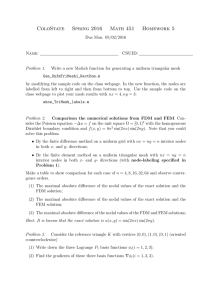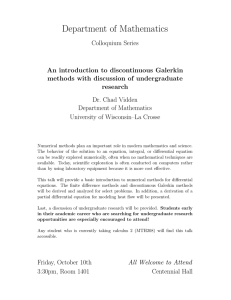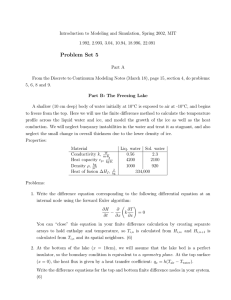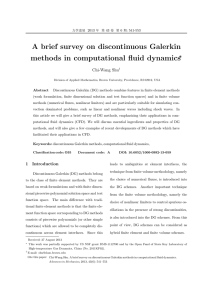16.901 Homework #5 Due Date: April 14, 2pm
advertisement
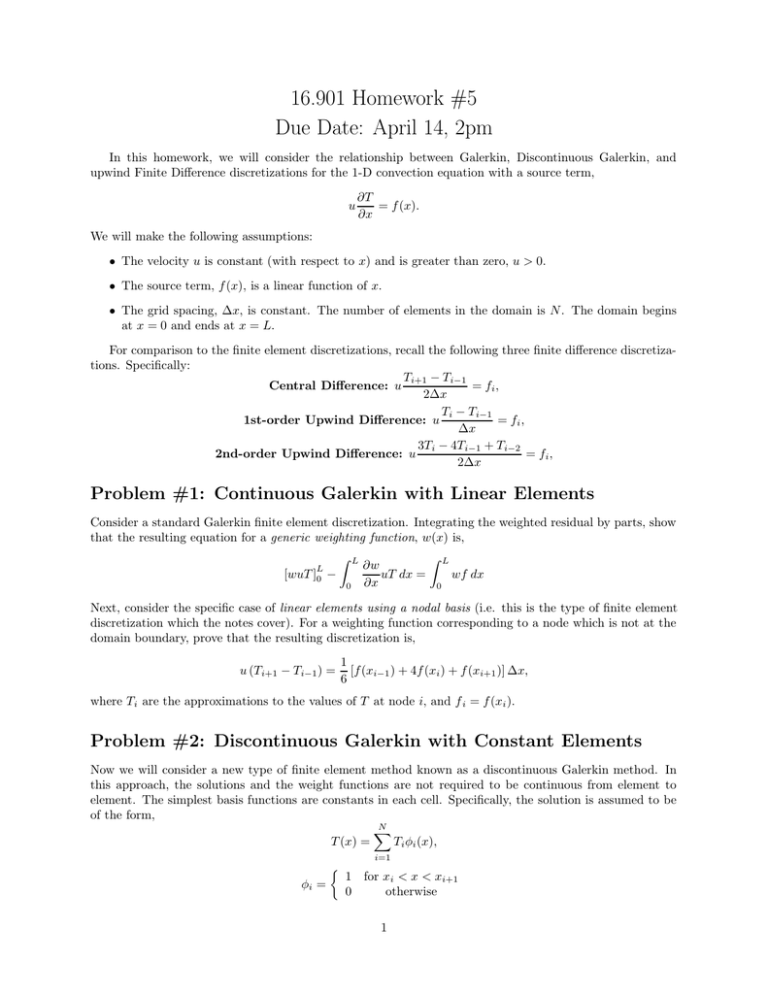
16.901 Homework #5 Due Date: April 14, 2pm In this homework, we will consider the relationship between Galerkin, Discontinuous Galerkin, and upwind Finite Difference discretizations for the 1-D convection equation with a source term, u ∂T = f (x). ∂x We will make the following assumptions: • The velocity u is constant (with respect to x) and is greater than zero, u > 0. • The source term, f (x), is a linear function of x. • The grid spacing, Δx, is constant. The number of elements in the domain is N . The domain begins at x = 0 and ends at x = L. For comparison to the finite element discretizations, recall the following three finite difference discretiza­ tions. Specifically: Ti+1 − Ti−1 Central Difference: u = fi , 2Δx Ti − Ti−1 1st-order Upwind Difference: u = fi , Δx 3Ti − 4Ti−1 + Ti−2 2nd-order Upwind Difference: u = fi , 2Δx Problem #1: Continuous Galerkin with Linear Elements Consider a standard Galerkin finite element discretization. Integrating the weighted residual by parts, show that the resulting equation for a generic weighting function, w(x) is, L [wuT ]0 − � 0 L ∂w uT dx = ∂x � L wf dx 0 Next, consider the specific case of linear elements using a nodal basis (i.e. this is the type of finite element discretization which the notes cover). For a weighting function corresponding to a node which is not at the domain boundary, prove that the resulting discretization is, u (Ti+1 − Ti−1 ) = 1 [f (xi−1 ) + 4f (xi ) + f (xi+1 )] Δx, 6 where Ti are the approximations to the values of T at node i, and f i = f (xi ). Problem #2: Discontinuous Galerkin with Constant Elements Now we will consider a new type of finite element method known as a discontinuous Galerkin method. In this approach, the solutions and the weight functions are not required to be continuous from element to element. The simplest basis functions are constants in each cell. Specifically, the solution is assumed to be of the form, N � T (x) = Ti φi (x), i=1 φi = � 1 for xi < x < xi+1 0 otherwise 1 In this case, Ti represents the solution in element i. Using integration by parts, prove that weighted residual corresponding to the weighting function for element i is, � xi+1 xi+1 [uT ]xi = f dx. xi Note: the integral of the source term will be simplified further in the next step. The usual approach for the discontinuous Galerkin method is to use an upwind flux to evaluate uT at the ends of element (i.e. at x = xi and xi+1 ). For example, uT (xi ) would be evaluated using T (x) from element i − 1 since this element is upwind of node i. Using an upwind flux, and simplifying the source term since it has been assumed to be linear in x, show that the resulting discretization for this problem is, uTi − uTi−1 = 1 [f (xi ) + f (xi+1 )] Δx, 2 Problem #3: Discontinuous Galerkin with Linear Elements Now, consider the discontinuous Galerkin approximation with linear elements, i.e. the solution varies linearly within each element. Instead of using a nodal basis within each element, use a basis for which the unknowns are the value of T and its derivative dT /dx at the midpoint of each element. For this basis, derive the weighted residual equations for each element (note: there are two equations for each element). Problem #4: Comparisons with Finite Difference Methods How do the three finite element discretizations compare to the finite difference discretizations? Discuss both similarities and differences between the different discretizations. 2
